 Oregon is one of the most diverse states to photograph. From the sea stacks along the coast, to the Columbia River Gorge, to the Northern Cascades, to Mt. Hood, to the sand dunes at Christmas Valley, to Crater Lake National Park, and I could go on and on. Oregon is a photographer’s paradise. The photographic opportunities are only limited by the amount of time you have.
Oregon is one of the most diverse states to photograph. From the sea stacks along the coast, to the Columbia River Gorge, to the Northern Cascades, to Mt. Hood, to the sand dunes at Christmas Valley, to Crater Lake National Park, and I could go on and on. Oregon is a photographer’s paradise. The photographic opportunities are only limited by the amount of time you have.
In mid-June I had the opportunity to photograph in two areas within Oregon – the well-known Columbia River Gorge and the lesser known Painted Hills. The Columbia River Gorge is outside of Portland and because of its accessibility, is heavily photographed. The multitude of waterfalls and lush greenery are spectacular. In many locations, you literally had to wait for photographers to move out of your way so you could shoot. In contrast, over the course of 3 days in the Painted Hills, I saw less than 20 people.
There was something other-worldly about the Painted Hills, not unlike some of my other favorite locations, such as the Atacama Desert, White Sands, Death Valley and the Namibian desert (see “Sand, Wind and Time” portfolio on my website). In a previous blog post, “I Love the Desert” I wrote about my fascination with the desert, and while the Painted Hills is not and was never desert, my attraction to the scenery was similar – you had the feeling that this place was unlike any others you had ever seen. It’s as if you were visiting another planet.
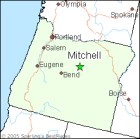 Not to be confused with the Painted Desert in Arizona, the Painted Hills is located in central Oregon, with the closest town being Mitchell (population 1,750). There are very limited accommodations in Mitchell, and because of the lateness of my travel plans, we stayed in the next closest town, Prineville, which is about 40 miles away. The Painted Hills is one of three “units” of the John Day Fossil Beds National Monument. John Day, a Virginian, was an early explorer and in 1811 was part of the Astor Expedition, that traveled west through South Dakota and Wyoming and into Oregon.
Not to be confused with the Painted Desert in Arizona, the Painted Hills is located in central Oregon, with the closest town being Mitchell (population 1,750). There are very limited accommodations in Mitchell, and because of the lateness of my travel plans, we stayed in the next closest town, Prineville, which is about 40 miles away. The Painted Hills is one of three “units” of the John Day Fossil Beds National Monument. John Day, a Virginian, was an early explorer and in 1811 was part of the Astor Expedition, that traveled west through South Dakota and Wyoming and into Oregon.
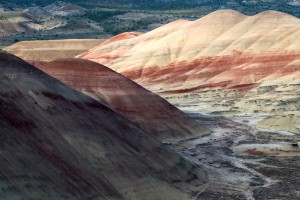 The Painted Hills, formed over 35 million years ago, is a relatively small, 3100 acre area consisting of incredibly beautiful hills that display the geological eras through the exposed layers of lignite, mudstone, siltstone, shale and laterite. In fact, the area was an ancient river floodplain, and the black portions of soil (lignite) that you see are the remains of vegetative matter. The red colored laterite soil, which is rich in iron oxide and aluminum formed when the area was a hot, wet tropical floodplain. Archeologists have found fossil remains of early horses, camels, elephants, rhinos and saber tooth tigers.
The Painted Hills, formed over 35 million years ago, is a relatively small, 3100 acre area consisting of incredibly beautiful hills that display the geological eras through the exposed layers of lignite, mudstone, siltstone, shale and laterite. In fact, the area was an ancient river floodplain, and the black portions of soil (lignite) that you see are the remains of vegetative matter. The red colored laterite soil, which is rich in iron oxide and aluminum formed when the area was a hot, wet tropical floodplain. Archeologists have found fossil remains of early horses, camels, elephants, rhinos and saber tooth tigers.
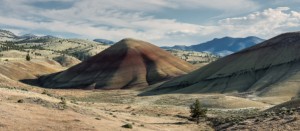 The colors of the land and hills ebb and flow in intensity, and are best at sunrise and sunset when the light emphasizes an ever-changing palette of reds, orange, yellow, black and green. Rain and moisture deepen the tones, so an ideal time to photograph would be after a rain. While I saw only one tiny location with a few remaining wildflowers, had I arrived a month earlier, the abundant yellow wildflowers in the area would have punctuated the colorful strata.
The colors of the land and hills ebb and flow in intensity, and are best at sunrise and sunset when the light emphasizes an ever-changing palette of reds, orange, yellow, black and green. Rain and moisture deepen the tones, so an ideal time to photograph would be after a rain. While I saw only one tiny location with a few remaining wildflowers, had I arrived a month earlier, the abundant yellow wildflowers in the area would have punctuated the colorful strata.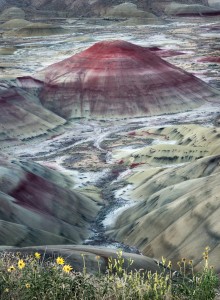
While the Painted Hills is a small geographical location, it would have been hit or miss had we attempted to photograph there on only one occasion. The first evening we were able to shoot, but the winds were blowing at 35-40 mph and it was difficult to steady the tripod and camera, but we had some success. We were able to photograph the next morning at sunrise, but when we returned for sunset, a thick cloud bank blocked the unseen setting sun and any remnant of beautiful light. In fact, I struck up a conversation with one of the few people we saw. He had driven 4 hours with his family to see sunset at the Painted Hills and all he could do was watch the hills fade away into totally flat, lifeless darkness. He was driving four hours back after the sun (which he never saw) set. The next morning we were rained out. Such are the frustrations of the landscape photographer!
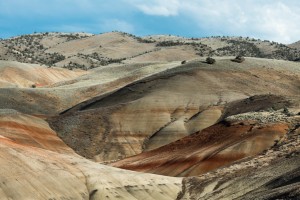 The Painted Hills is a tiny jewel within a state that is filled with monumental photographic opportunities; but a jewel that was well worth the visit.
The Painted Hills is a tiny jewel within a state that is filled with monumental photographic opportunities; but a jewel that was well worth the visit.


Hi, Alan. Great post! While we won’t be able to visit the Painted Hills on this trip, we will be doing the west coast of Oregon in about ten days. But I will store away this information for a future trip. Very helpful, indeed.
Regards,
Robin